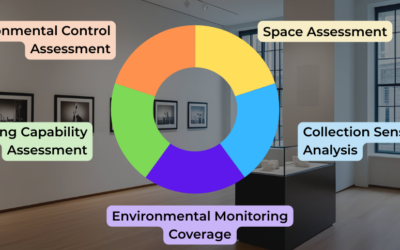The field of collections care is incredibly diverse. Two crucial roles in the institutional heritage world are museum technicians and conservators. While not all institutions will have both, with many only having one or the other, when possible, these professionals work together to ensure the preservation, presentation, and longevity of cultural heritage. This post explores the roles, responsibilities, and challenges of museum technicians and conservators, providing insights into the multifaceted world of collections care.
Roles and responsibilities of museum technicians
The term “museum technician” can apply to a position with a wide variety of responsibilities which may encompass several other professional titles. Sometimes referred to as art handlers, collections specialists, preparators, or even registrars (U.S. Bureau of Labor Statistics), museum technicians play a vital role in the management and care of collections. They can be responsible for preventive care and handling of artifacts and perform tasks normally associated with registrars such as documentation, acquisitions, inventory and cataloging.
Preparators, specifically, will focus on preparing objects for display or storage. This may also include mountmaking, although some larger museums will have dedicated mountmakers among their staff. It is also possible that different emerging collection professionals with various museum studies or conservation degrees may start their careers with a generic title such as “museum technician” before they move on to other positions.
One interesting point about the term “museum technician” is that it may (although not always) imply a lower pay scale as the word “technician” can be leveraged to look for an employee without a completed postgraduate degree in the field. This may include emerging professionals and people with certificates/diplomas or from apprenticeship education paths.
Roles and responsibilities of conservators
Conservators work to slow down or prevent deterioration and sometimes restore damaged artifacts in the collection. Their work involves detailed examination, documentation, treatment, and preventive care, guided by the ethics and standards of either national or international professional associations such as the American Institute for Conservation (AIC) or the Conservation Committee of the International Council of Museums (ICOM-CC). Conservation treatments involve a considered understanding of the material science of the artifacts, as well as the historical nuances and significance of the objects. Ethical considerations regarding what should or should not be done are also at play, so conservators often collaborate with and consult source communities, scientists, historians, and artists (among others) before making treatment decisions.
In some cases, conservators specialize in preventive conservation. This means that instead of treating collections on an object-per-object basis, they monitor and act upon the environmental surroundings of collections instead. This may involve focusing on enclosures, pollution, relative humidity and light exposure, among other factors. Professionals who trained as conservators may have a job with the “museum technician” title, but these two names are not interchangeable. Not all conservators consider themselves museum technicians and not all museum technicians were necessarily trained as conservators.
Challenges faced by museum technicians and conservators
Both museum technicians and conservators need to possess a combination of skills and knowledge in art, science, history, and technology. They also need to have excellent manual dexterity, attention to detail, problem-solving abilities, and communication skills. Handling objects is also a crucial skill that they must master to perform their duties effectively.
Despite the rewarding nature of their work, museum technicians and conservators face several challenges which may include:
- Budget constraints that can limit the resources available for collection care.
- Constant need for (expensive) professional development to keep up with advancements in the field.
- Physical fitness to overcome the challenges of working with delicate and sometimes heavy objects that need to be handled into different rooms and spaces.
- Stresses related to working with collections with difficult histories and the ethical dilemmas of treating objects according to ethical guidelines.
- Potential health risks when working with hazardous collections that may include poisonous objects or items that have been previously treated with toxic pesticides. Check out the poison book project at the University of Delaware Winterthur Conservation Program for an excellent example.
- Lack of public recognition as most of their work occurs in inaccessible areas to the general public.
- Lack of job stability and fair remuneration. Many jobs related to conservation and collections care are contract-based or temporary. This requires professionals to return to the job market periodically and be at the mercy of their ability to relocate for work.
How can museum technicians and conservators overcome these challenges?
Despite the challenges, there are several things you can do to address them. Here are some ideas:
- Seek support from colleagues, supervisors, and professional associations. There are many groups with distribution lists and forums where you can share information and supportive thoughts. Try the Conserv Community, for example. If you’d rather remain anonymous, there are large Reddit groups for museum workers such as r/MuseumPros.
- If your job doesn’t have a budget for your professional development, take advantage of the myriad free resources, webinars and courses available online. If you don’t know where to start, check out this article we wrote recently with free resources for preventive conservation education.
- If you are so inclined, consider volunteering for a committee position in your professional organization. This will allow you to network with your peers and increase your name recognition, which will undoubtedly help you during a future job search.
- Look into current initiatives pushing for salary transparency such as the ones by NEMPN. Their database and information may help you get better insights on fair compensation.
- Ensure your team is aware of the potential psychological and physical health risks for your collections. This will allow you to manage the risks of handling and care.
The importance of museum technicians and conservators
The roles of museum technicians and conservators are critical to preserving cultural heritage. Their knowledge, skills, and dedication directly contribute to the longevity of artifacts and the education of the public. By understanding the roles, responsibilities, and challenges of these professionals, we can better appreciate the intricacies involved in collections care and the importance of providing ongoing support and resources for these crucial roles.
If you are not a museum technician or conservator yourself but manage these positions in your institution, don’t forget to nurture the Team approach for improved collections care and a happier work environment. We hope this article pointing out some of the common challenges faced by heritage professionals will help you work towards improved conditions for your staff. Your employees will be grateful for the opportunities you can build for them to grow and practice their skills in a sustainable and fulfilling manner.
If you have any questions about environmental monitoring, integrated pest management, or just want to talk about preventative conservation, please reach out to us! Don’t forget to check out our blog or join our community of collections care professionals where you can discuss hot topics, connect with your peers or even take a course to get familiar with the Conserv platform.




